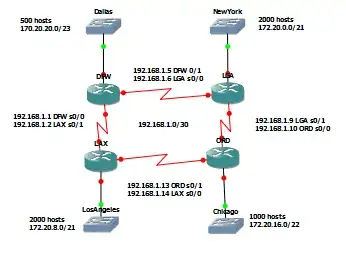I'm studying for the CCNA exam and I want to create a VLSM scheme using RIPv2 for the following (CCNA practice example):
- Network connecting 4 different locations
- Each switch is fa 0/0 on the router
- Every point-to-point serial connection is in the network is class C (192.168.1.0 )
- Network 172.20.0.0 for each location
- Use the lowest subnet number (zero is allowed)
Requirements for each location:
- Dallas - 500 hosts
- New York - 2000 hosts
- Chicago - 1000 hosts
- LA - 2000 hosts
Here's my design so far:

Do you see any flaws in this? How would you fix them? Or how would you design this?
